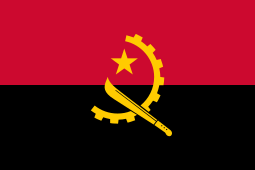History of Angola:
Angola was occupied by Bushmen and tribes until it became part of the Kingdom of Congo in the 13th century. Northern Angola was part of the Kingdom of Congo, and most of southern Angola came under the control of the Kingdom of Ndongo. They were ruled by a king named Ngora.
In 1482, Diogo Cao Cao and the Portuguese arrived in Angola. They started trading with the King of Congo and established a colony in 1575. Portugal gradually occupied what is now Angola. They were particularly interested in the slave trade. They bought slaves from local chiefs and kings and sold them to Brazil and America. Angola became one of Africa’s largest suppliers of slaves.
In the 1960s, many rebel groups formed to create a better environment for Angola’s indigenous peoples. There was a lot of racism in this country and very little development. Three main groups were formed: MPLA (People’s Movement for the Liberation of Angola), FNLA (National Front for the Liberation of Angola) and UNITA (National Union for Total Independence of Angola). These groups fought for independence and Angola has experienced many civil wars and conflicts over the years.
Angola gained independence on November 11, 1975. Leadership was given to three major groups (MPLA, FNLA and UNITA) but they could not agree and all wanted power. A civil war broke out in Angola. The MPLA once ruled as a Marxist communist government. Elections were held for him in 1992, but not until 2005. It is still a country torn apart by civil war and conflict.
Information about Angola:
| Capital | Luanda |
| Population | 36,880,753 (Source: 2023 worldometer) |
| Major Cities | Luanda (capital), N’dalatando, Huambo, Lobito, Benguela, Cabinda, Malanje, Uige |
| Borders | Republic of the Congo, to the north and northeast by the Democratic Republic of the Congo, to the southeast by Zambia, to the south by Namibia, and to the west by the Atlantic Ocean |
| Gross Domestic Product (GDP) | $106,714,000,000 (2022 worldometer) |
| Currency | kwanza (AOA) |
Flag of Angola:
Angola Economy Key Industries:
Angola Major Industries: petroleum; diamonds, iron ore, phosphates, feldspar, bauxite, uranium, and gold; cement; basic metal products; fish processing; food processing, brewing, tobacco products, sugar; textiles; ship repair
Angola Agricultural Products: bananas, sugarcane, coffee, sisal, corn, cotton, manioc (tapioca), tobacco, vegetables, plantains; livestock; forest products; fish
Angola Natural Resources: petroleum, diamonds, iron ore, phosphates, copper, feldspar, gold, bauxite, uranium
Angola Major Exports: crude oil, diamonds, refined petroleum products, gas, coffee, sisal, fish and fish products, timber, cotton
Angola Major Imports: machinery and electrical equipment, vehicles and spare parts; medicines, food, textiles, military goods
The Geography of Angola:
Total Size of Angola: 1.247 million km² (source: wikipedia)
Geographical Low Point of Angola: Atlantic Ocean 0 m
Geographical High Point of Angola: Morro de Moco 2,620 m
Climate of Angola: semiarid in south and along coast to Luanda; north has cool, dry season (May to October) and hot, rainy season (November to April)
General Terrain of Angola: narrow coastal plain rises abruptly to vast interior plateau
World Region or Continent of Angola: Africa
Geographical Coordinates: 12 30 S, 18 30 E
The People of Angola & Culture
Angola Government Type: republic; multiparty presidential regime
Angola Nationality: Angolan(s)
Angola National Holiday: Independence Day, 11 November (1975)
Angola Independence: 11 November 1975 (from Portugal)
Angola National Symbol: sable antelope
Angola National Anthem or Song: Angola Avante (Forward Angola)
Angola Languages Spoken: Portuguese (official), Bantu and other African languages
Angola Religions: indigenous beliefs 47%, Roman Catholic 38%, Protestant 15% (1998 est.)
Interesting Facts about Angola:
The name Angola comes from the local language Ngora, which refers to the title of the local King Ndongo. The Kingdom of Ndongo was his one of the largest kingdoms in the region.
The longest river in Angola is the Kwanza River, which is about 960 km long. It is the only river in Angola that is navigable throughout the country.
The largest city in Angola is Luanda, the capital. Luanda is also the oldest city in the country.
Angola’s largest lake is Diloro Lake near Cameia National Park, a birdwatcher’s paradise.
Angola’s highest peak is Mount Mocha at 2,620 m. This mountain is located in central-western Angola.
Kalandula Falls is the largest waterfall in Angola.
Iona National Park is Angola’s largest national park. The park is known for its unique rock formations and abundant wildlife, which impacts biodiversity despite high levels of poaching.
Angola has a tropical climate along the coast and a temperate climate in the plateaus and highlands. The coldest months are July and August.
The national animal is the giant sable antelope. This is the largest species of antelope and is found only in Angola. Sable antelopes are unfortunately an endangered species.
Angola is rich in wildlife. Years of war and illegal poaching have reduced biodiversity, but it is still home to nearly 300 mammal species and over 980 bird species. Common birds include herons, flamingos, ostriches and even albatrosses.


